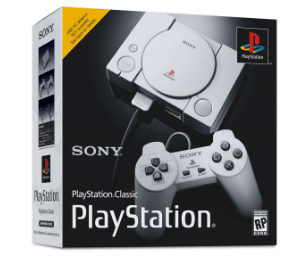Sony has joined the trend of launching retro consoles with the PlayStation Classic. The small, retro console comes with many of the original console’s best and most popular games.
Everything you need to know about the PlayStation Classic
The Sony PlayStation Classic comes almost 24 years after the launch of the original PlayStation in December 1994. In May, Sony Interactive Entertainment CEO John Kodera admitted the company had thought of releasing a Classic edition in the past, and three months later, Sony has announced the retro console.
“Today, we are excited to announce that we are bringing back the original PlayStation experience in a new miniaturized version – PlayStation Classic!” Sony said in a blog post announcing the new console. The Japanese company also released a video to introduce the new console:
Sony’s PlayStation Classic will be available in the U.S., Canada, Europe, Japan and Australia starting on Dec. 3. Similar to the SNES Classic, Sony’s retro console won’t include an AC adapter. Thus, the only power option will be the bundled USB cable. Users will need to buy a compatible USB AC adapter to enjoy the console.
The PlayStation Classic ships with an HDMI cable to connect to the TV, a USB cable and two original PS1 controllers. It costs $99.99 in the U.S., A$150 in Australia and €99.99 in Europe. The console is now available for pre-order at select retailers across the U.S. and the U.K. Sony advises fans to visit PlayStation.com to learn more about regional availability.
Very similar to the original PS
Some of the popular games the retro console will come up with are Ridge Racer Type 4, Tekken 3, Final Fantasy VII, Jumping Flash and Wild Arms. There will be 20 titles in total. The names of the other bundled titles have not yet been revealed, but the company has promised to announce other “legendary titles” before year-end. Sony also assures that all the pre-loaded games will be in their original format.
“Long-time fans will appreciate the nostalgia that comes with rediscovering the games they know and love, while gamers who might be new to the platform can enjoy the groundbreaking PlayStation console experience that started it all,” the Japanese company said.
The console is about 45% smaller than the original PlayStation. To give it a retro look, Sony tried its best to give it original packaging.
“…it emulates the original’s look and feel by featuring similar controllers and packaging,” Sony says.
Though it is smaller, the design of the Classic edition does remind us of the original PlayStation. It features the same layout and the same colorful PlayStation logo on top, but instead of cartridges, the PlayStation Classic uses onboard storage like other retro console versions.
Even the controllers are reminiscent of the original ones, featuring the traditional green triangle, red circle, blue cross, and pink square action button. Further, the controllers have four shoulder buttons, navigation controls, and select and start keys. The controllers also retain the original grip handles for the same ergonomic design that came with the original controllers.
Nostalgia is the driving force
Sony’s decision to launch a retro console follows Nintendo, which played the nostalgia card earlier by releasing the NES Classic Edition in July 2016 and the SNES Classic Mini last year. Both Nintendo consoles came with 30 pre-installed games. The SNES Classic was priced at $80, while the NES Classic Edition carried a price tag of $60.
Sega also brought back its retro console in 2016 in the form of the Mega Drive Classic Game Console. The console featured 80 pre-loaded games and Sega Mega Drive cartridge support. Sega also launched the Mega Drive Mini in April 2018.
Nostalgia is the primary driving force for retro consoles, which makes historical video games accessible even now. Gaming journalist Chella Ramanan believes retro consoles are nostalgic for those who grew up in the 1980s and 1990s and gives newer generations a chance to play iconic games.
“It was the first console I owned. Sony did an incredible marketing campaign, tapping into club culture to make games cool. It became a lifestyle thing for people in their 20s,” Ramanan said, according to the BBC.





